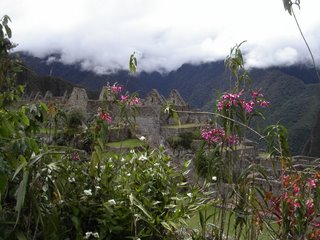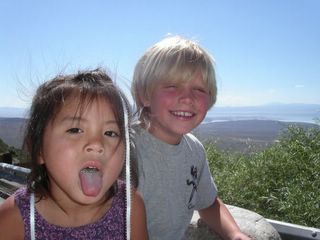So, who were these Incas anyway?




So, who were these Incas anyway? First, just to make things difficult, THEY weren’t really the Incas. The term Inca actually refers to the head honcho, the el jefe, THE Inca. The Spanish mistakenly applied the name to the entire group. Some scholars prefer to refer to the civilization in question as the Quechua as Quechua was the language spoken by the Incas and, interestingly, is still the common language of the locals in this area. But, even though referring to the civilization as the Incas is a bit of a misnomer, for the sake of simplicity, the mistake will be perpetuated in this blog, sort of like how those of us in the Americas refer to the indigenous people of the Western Hemisphere as Indians because some old dead White guy refused to stop and ask for directions and landed on the wrong continent.
Things really got rolling for the group that would become the Incas in the 1430s. Prior to that time they were a relatively small group who had lived a relative simple and peaceful in the Cusco Valley for two or three hundred years. However, on or around the early 1430s, their idyll was interrupted by the Chancas who, in rather poor taste, attacked the Cusqueños and, not only disrupted at least one entire afternoon’s diversions, but were in fact on the verge of defeating the Cusqueños. Things looked so dire, the leader of the Cusqueños actually fled town convinced that all was lost. His son, however, continued the fight and was able to get his people to rally so fiercely that, according to legend, even the stones fought on their side. As you can guess, the Chancas were defeated and the son took over the reigns of power adopting the title of Inca and the name Pachacutec, meaning “transformer of the earth.” He claimed to be divinely descended from the sun and his wife (who was also his sister) was the daughter of the moon. Therefore, much like the divine right of kings in Europe, as a direct descendent and local representative of God, to rebel against Pachacutec was to rebel against God himself. As a result of their experiences with the Chancas, the Incas, under Pachacutec, switched their foreign relation’s strategy and began a period of expansion and imperialism that was as ruthless as that of the Spanish at whose hands they would eventually be defeated (any parallels with current events can be drawn by yourself). Within Pachucatec’s lifetime, the Incan empire was extended from as far North as what is now Columbia and as far South as present-day Chile. Groups that resisted were summarily vanquished and the defeated people were often either slaughtered or relocated. Rather than face this fate, other groups who joined the Kingdom willingly, “the Incas may now be in charge but at least they brought in sewer and water,” maintained a large degree of regional autonomy as long as they worshipped Inti, the sun, as their supreme God (after all, it seemed to be working well for the Incas) and paid levies, often in the form of labor for the massive building projects that were being undertaken by the Incas. The Incas, for their part, often integrated some of the newly annexed culture’s religious themes into their own. They also studied the new culture’s agricultural, architectural, metallurgical, medicinal, textile and pottery techniques and were thus able to integrate an extensive body of knowledge into their own in a relatively small period of time. As a result, they were able to develop intensive agricultural practices, developing new strains of crops in places like Maray that could grow in the high elevations of the Andes and, in order to maximize the amount of arable land in this mountainous region, they built extensive terracing systems, some of which are still in use today. The Incas didn’t have much for domestic livestock beyond llamas and alpacas before the Spanish arrived but they were consummate farmers. Consequently food was produced at a level surpassing current production allowing the empire to support a larger population than that of today while storing enough food to feed the population during bad years and eliminating hunger throughout the empire. The leaders of these captured peoples were brought to Cusco as Vassals were they lived in relatively comfort and opulence as long as their subjects bacsk home continued to cooperate. By this time, Cusco, known to the Incas as the “navel of the world,” was a fairly cosmopolitan city of about 100,000 homes in which scores of languages were spoke although Quechua was used universally. By the time the Spanish arrived in Cusco, they found a city that, according to one of Pizarro’s men, “is so beautiful and has such fine buildings that it would be remarkable even in Spain.” The religious center of Cusco, the Qoricancha, consisted of a number of temples – to the sun, the moon, to rainbows, thunder and lightning, and the stars – some of which had walls that were completely covered in gold or silver. A large golden sun disc reflected the sun’s rays into the gold-lined temple of the sun, filling the entire temple with the golden radiance of the sun. There were ritual treasures representing objects of import to the lives of the Incas: a field of corn with stems and leaves made from silver and ears made from gold as well as llamas, butterflies, birds, plants and trees all made of pure gold.
Alongside the ongoing imperial expansion, under Pachucatec the Incas began massive building projects like Pisac, Ollantaytambo, Machu Picchu, Sacsaywaman as well as hundreds of other less well known constructions including wacas (shrines) and tambos (post-houses for royal messengers who ran throughout the empire delivering messages coded on knotted ropes). The sites were located on a system or radiating lines or ceques from the center of Cusco and were maintained by regional clans or kinship groups known as ayllus. The construction techniques utilized by the Incas continue to amaze and impress laymen and experts alike. All of these sites were connected by over 40,000 km of paved roads over rugged mountainous terrain utilizing bridges, tunnels, drainage ditches, etc. in the process. These sites were built to last and many remain virtually unchanged, a testament to the building techniques of the Incas.
Food and other resources were shared by al throughout the Incan empire but this was no hippie commune giving lip-service to equality, rather the Incan society was strictly and hierarchically organized with the head Inca at the top followed by lesser nobility and others on down the line each responsible for progressively smaller and smaller groups of people. Inca rulers and other nobility were often mummified after death and continued to be consulted on important matters although the conversations must have been somewhat one-sided. They were given daily offerings of food and drink and taken out and paraded around town on special occasions (perhaps not unlike our Señor de los Tremblores?).
The Inca civilization was one of the largest and most successful pre-modern civilizations. In terms of size and effective governance, the Incas were on par with the Roman Empire. Their dominance in South American seemed assured until a group of bearded strangers appeared on the scene.


0 Comments:
Post a Comment
<< Home